This article needs additional citations for verification .(July 2014) |
| LMS 5000 | |||||||||||||||||||||||||||||||||||||||||||||||||||||||||||||||||
|---|---|---|---|---|---|---|---|---|---|---|---|---|---|---|---|---|---|---|---|---|---|---|---|---|---|---|---|---|---|---|---|---|---|---|---|---|---|---|---|---|---|---|---|---|---|---|---|---|---|---|---|---|---|---|---|---|---|---|---|---|---|---|---|---|---|
 No. 5000 in 1982 | |||||||||||||||||||||||||||||||||||||||||||||||||||||||||||||||||
| |||||||||||||||||||||||||||||||||||||||||||||||||||||||||||||||||
| |||||||||||||||||||||||||||||||||||||||||||||||||||||||||||||||||
| |||||||||||||||||||||||||||||||||||||||||||||||||||||||||||||||||
| |||||||||||||||||||||||||||||||||||||||||||||||||||||||||||||||||
LMS Stanier Class 5 4-6-0 number 5000 is a preserved British steam locomotive. It is part of the National Railway Collection.
This article needs additional citations for verification .(July 2014) |
| LMS 5000 | |||||||||||||||||||||||||||||||||||||||||||||||||||||||||||||||||
|---|---|---|---|---|---|---|---|---|---|---|---|---|---|---|---|---|---|---|---|---|---|---|---|---|---|---|---|---|---|---|---|---|---|---|---|---|---|---|---|---|---|---|---|---|---|---|---|---|---|---|---|---|---|---|---|---|---|---|---|---|---|---|---|---|---|
 No. 5000 in 1982 | |||||||||||||||||||||||||||||||||||||||||||||||||||||||||||||||||
| |||||||||||||||||||||||||||||||||||||||||||||||||||||||||||||||||
| |||||||||||||||||||||||||||||||||||||||||||||||||||||||||||||||||
| |||||||||||||||||||||||||||||||||||||||||||||||||||||||||||||||||
| |||||||||||||||||||||||||||||||||||||||||||||||||||||||||||||||||
LMS Stanier Class 5 4-6-0 number 5000 is a preserved British steam locomotive. It is part of the National Railway Collection.
5000 was built at Crewe in 1935 and was initially the first numerically of its class. It however was not the first to be built because the Vulcan Foundry had turned out the first of their simultaneous order, No. 5020 in 1934. It also ceased to be the first numerically when No. 4800 was built in 1944, after the LMS ran out of available numbers after No. 5499 was built.
5000 was built with a low degree superheat domeless boiler.
5000 had 40000 added to its number to become 45000 after nationalisation in 1948 by British Railways.
After withdrawal from Lostock Hall shed, near Preston in 1967, 5000 was selected to represent its 842-strong class as part of the National Railway Collection. Part of the reason for this was that it had a domeless boiler and was roughly in the condition as built. It was therefore painted in its original LMS lined black livery. However, there had been changes over its lifetime and as a result there are numerous detail differences between 5000 as built and 5000 as preserved.
5000 was steamed on the Severn Valley Railway and on the mainline in preservation. In 1980, 5000 attended The Rocket 150 celebrations at Rainhill, where she hauled a short mixed goods which included 2 flatwagons carrying a replica of the engine Novelty, & The Earl from the Welshpool and Llanfair Railway, which at the time was on loan to the NRM before returning to Welshpool by the late 1990s. Since its boiler certificate expired in 1990, it has been restricted to being a static exhibit and as of January 2016 [update] it is on display at the Shildon Locomotion Museum in County Durham. [1]

The London, Midland and Scottish Railway (LMS) Princess Royal Class is a class of express passenger 4-6-2 steam locomotive designed by William Stanier. Twelve examples were built at Crewe Works, between 1933 and 1935, for use on the West Coast Main Line. Two are preserved.
The London, Midland and Scottish Railway had the largest stock of steam locomotives of any of the 'Big Four' Grouping, i.e. pre-Nationalisation railway companies in the UK. Despite early troubles arising from factions within the new company, the LMS went on to build some very successful designs; many lasted until the end of steam traction on British Railways in 1968. For an explanation of numbering and classification, see British Rail locomotive and multiple unit numbering and classification.

The London, Midland and Scottish Railway (LMS) Jubilee Class is a class of steam locomotive designed for main line passenger work. 191 locomotives were built between 1934 and 1936. They were built concurrently with the similar looking LMS Stanier Class 5 4-6-0. They were nicknamed Red Staniers and Jubs.

The London, Midland and Scottish Railway Fowler Class 7F was a class of 0-8-0 steam locomotives. They were a Midlandised version of the London and North Western Railway (LNWR) Class G2 and Class G2A 0-8-0s. They were also classified as Class G3 under the former LNWR system. The class were sometimes known as Baby Austins, or Austin 7s, after a motor car that was becoming popular at the time.
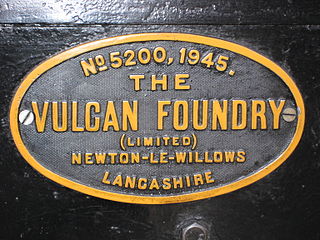
The Vulcan Foundry Limited was an English locomotive builder sited at Newton-le-Willows, Lancashire.
The London and North Eastern Railway (LNER) produced several classes of locomotive, mostly to the designs of Nigel Gresley, characterised by a three-cylinder layout with a parallel boiler and round-topped firebox. It produced the most famous locomotive of its day, 4468 'Mallard', the holder of the world steam locomotive speed record. It also built the world-famous 4472 'Flying Scotsman'. However, its locomotive inheritance was much greater than just the 'A4 Class', it also produced highly successful mixed-traffic and freight designs.

The London, Midland and Scottish Railway (LMS) Stanier Class 5 4-6-0, commonly known as the Black Five, is a class of 4-6-0 steam locomotives. It was introduced by William Stanier and built between 1934 and 1951. A total of 842 were built initially numbered 4658-5499 then renumbered 44658-45499 by BR. Several members of the class survived to the last day of steam on British Railways in 1968, and eighteen are preserved.

Under the Whyte notation for the classification of steam locomotives, 0-4-4 represents the wheel arrangement of no leading wheels, four powered and coupled driving wheels on two axles, and four trailing wheels on two axles. This type was only used for tank locomotives.

The London Midland and Scottish Railway (LMS) Stanier Class 5 2-6-0 or Stanier Mogul is a class of 2-6-0 mixed traffic steam locomotives. Forty were built between October 1933 and March 1934.
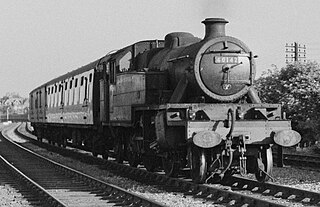
The Stanier Class 3P 2-6-2T was a class of London, Midland and Scottish Railway (LMS) steam locomotive. They were designed by William Stanier based on the earlier LMS Fowler 2-6-2T.
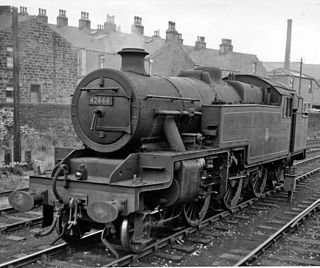
Sir William Stanier's London, Midland and Scottish Railway (LMS) Class 4P 2-Cylinder 2-6-4T was a class of 206 steam locomotive built between 1935 and 1943. They were based on his LMS 3-Cylinder 2-6-4T.

Crewe Works is a British railway engineering facility located in the town of Crewe, Cheshire. The works, which was originally opened by the Grand Junction Railway in March 1843, employed around 7,000 to 8,000 workers at its peak. In the 1980s much of the engineering works were closed. Most of the site has been redeveloped, but the remaining parts are owned and operated by Alstom.
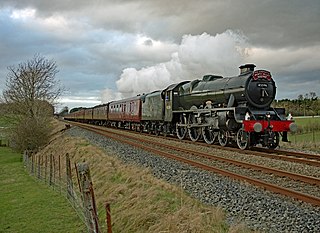
London, Midland and Scottish Railway (LMS) Jubilee Class 5596Bahamas is a preserved British steam locomotive. It is named after The Bahamas.

London, Midland and Scottish Railway Jubilee Class 5593 named Kolhapur is a preserved British steam locomotive.

London, Midland and Scottish Railway (LMS) Stanier Class 5 4-6-0 No. 5110 is a preserved British steam locomotive. It has carried the name RAF Biggin Hill in preservation, though it never carried this in service. Number 5110 was built in 1935 by the Vulcan Foundry. It was built with a low-degree superheat domeless boiler and still carries a domeless boiler.

The London and North Eastern Railway (LNER) Class O6 was a class of 2-8-0 steam locomotives of the Stanier Class 8F type.

The Fifteen Guinea Special was the last main-line passenger train to be hauled by steam locomotive power on British Rail on 11 August 1968 before the introduction of a steam ban that started the following day, the extra day added to allow for the movement of locomotive BR Standard Class 7 70013 Oliver Cromwell to Bressingham Steam Museum. It was a special rail tour excursion train organised for the occasion from Liverpool Lime Street via Manchester Victoria to Carlisle and back, and was pulled in turn by four steam locomotives during the four legs of the journey. The last scheduled standard gauge steam-hauled passenger services had run on 3 August 1968 from Preston. Steam continued to be used on the narrow gauge Vale of Rheidol Railway under British Rail, which was subsequently privatised in 1989.

LMS Stanier Class 5 4-6-0 No. 44806 is a preserved British steam locomotive. It was built at Derby in 1944.

The London Midland and Scottish Railway (LMS), Rebuilt Patriot Class was a class of 4-6-0 steam locomotives. They were rebuilt from LMS Patriot Class locomotives over the period 1946–1949. By the end of 1947, the LMS had rebuilt seven engines, these being 5514/21/26/29–31/40. After nationalisation, a further eleven locomotives were rebuilt. Rebuilt locomotives retained their numbers.
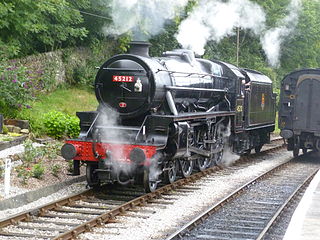
LMS Stanier Class 5 4-6-0 No. 45212 is a preserved British steam locomotive. It was built by Armstrong Whitworth at Newcastle upon Tyne in 1935.